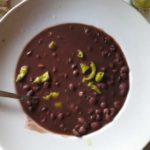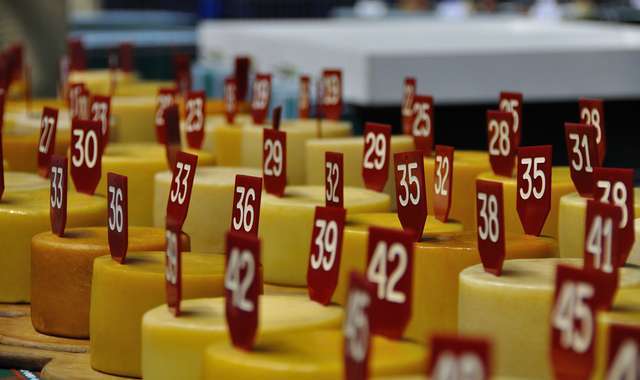By Sofia Perez
[Published by ZesterDaily.com, October 29, 2013]
Seated in the center of a jai alai court, surrounded by men in berets and young girls dressed like extras from the old TV series Little House on the Prairie, I began tasting my way through 21 sheep’s milk cheeses while people sat in the bleachers to watch. No, this was not a dream, though it was the closest I’ve ever come to an out-of-body experience.
But first, a little backstory.
Since becoming a food writer more than ten years ago, I’ve visited Spain’s Basque Country often, and have forged many wonderful friendships. This summer, after confirming I’d be returning in September to report two articles for Saveur, I began contacting the folks I knew. Days later, an email popped into my inbox from Jesús Mari Ormaetxea, the “Grand Master” of the Idiazabal Cheese Association in Ordizia, inviting me to be a judge for the village’s annual cheese contest, to take place during my stay.
Recalling the fun I’d had several years earlier as a judge for a snail contest in another Basque town (don’t ask), I accepted immediately. It wasn’t until later that the panic set in, right around the time I started receiving file after file from Ormaetxea—among them, an 18-page dossier on the contest; a 32-page full-color .pdf file on Idiazabal cheese; and my formal invitation signed by the head judge, chef Juan Mari Arzak, the father of Spain’s modern culinary renaissance. So hey, no pressure.
I already knew the small town was famous for its weekly farmers’ market, and agriculture and shepherding have been a part of life in the area for centuries, with Idiazabal being one of its most famous food products. The documents also informed me that 2013 marked the 40th official year of this event, though Ordizia has been staging cheese competitions since at least 1904. To enter the contest, participants have to be shepherds who produce their cheeses artisanally, using milk from their own herds.
Riding to the event from Bilbao with a friend and fellow judge, journalist Mikel Zeberio, I breathed a sigh of relief when he said there’d be more than 20 others on the panel with us. Maybe I wouldn’t singlehandedly destroy this longstanding celebration of cultural pride with my relative inexperience.
In the car, Zeberio explained we’d be scoring the entries on a scale of 0 to 10, evaluating eight different traits: shape; rind; color (of the interior); quantity and quality of the “eyes,” or holes (which can reveal production defects); texture; aroma; taste; and aftertaste. The points awarded in the various categories would be weighted according to the attribute’s overall importance when tallying the score for each cheese.
Holding court

(l-r.) Arbelaitz, Castillo, and yours truly, trying to disguise my panic as we judge endless amounts of cheese
Every Basque town worth its sheep’s milk has its own frontón, a court where jai alai (a sport these people invented) and pelota (the basket-less version) are played, watched, and wagered upon. A center of community life, it’s the ideal spot for this type of gathering—bleachers included, wagering optional.
When we arrived, we were divided among seven tables, six of which featured three judges apiece—a journalist, cheese expert and chef/restaurateur—while the seventh table comprised top dignitaries, including the high-profile Basque chefs Martín Berasategui and Pedro Subijana. My charming colleagues at Table 5 were Hilario Arbelaitz, chef of the Michelin-starred Zuberoa near San Sebastián, and Monica Castillo, proprietor of Vintage, a wine bar in Vitoria-Gasteiz.
All told, 53 Idiazabal cheeses were submitted for consideration. In the first round, each table was asked to choose the best two (out of seven or eight) to advance. Later, all the judges would taste and score the 14 finalists.
In case I needed further proof that these people were not playing, the official ballot looked like a cross between a baseball scorecard and an SAT answer sheet. Each cheese had its own row of empty boxes printed above perforated lines so the scores could be torn off and collected. There would be no changing your mind once you’d written down your numbers (which were imprinted on a carbon copy under the main ballot for good measure). I’m not going to lie: This may have been when I started to sweat. Sure, I was familiar with Idiazabal, but would I be able to distinguish among so many iterations of the same product?
After the audience filed in, a woman began reading bios of all the judges, working her way down the row over and over, calling to mind that episode of The Brady Bunch where the mom tells the kids not to play ball in the house. Though the emcee’s tone was cheerful, I couldn’t help but feel a little like a suspect in a police lineup. It seemed odd anyone would want to watch people sniffing and tasting dairy products for three hours, but it made more sense when I learned the winner would take home 1,550 Euros (about $2,100).
As we began evaluating the contenders, I was surprised by the variation; some cheeses were overly acidic, others smelled too much of the barnyard, and a few were grainy and dry. In the end, my favorite did not take first place, though the winner was among those I had rated most highly. For his achievement, Ricardo Remiro Agirre earned a large golden trophy, the prize money, and 5,000 “Champion of Ordizia” labels to affix to his cheeses.
Looking back now, I have many memories from that unusual day, but the most humbling was watching the five finalists collect their awards. A few pumped their fists, one was nearly in tears, and Remiro Agirre beamed with pride as he walked to the podium with his wife and two young boys in tow. While the local press snapped photos and the audience hooted, the older son looked down at his feet. Upon closer inspection, though, I spotted the hint of a shy smile on the boy’s face. At a time when so many food traditions are disappearing, I hope the events of the day might inspire that child to take up his father’s craft.



